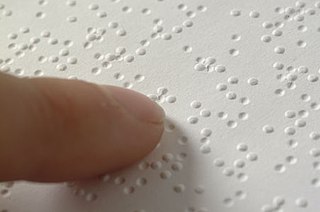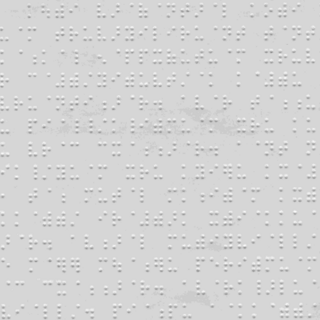Alphabet
Since French Braille does not have a letter for ó, Italian Braille uses ⠬ò for both ò and ó.
If other letters are needed, such as j, k, w, x, y or accented vowels such as î, French Braille assignments are used. ⠚j is used as the digit 0.
| Italian Braille | |
|---|---|
| Script type | alphabet |
Print basis | Italian alphabet |
| Languages | Italian |
| Related scripts | |
Parent systems | Braille
|
Italian Braille is the braille alphabet of the Italian language, both in Italy and in Switzerland. It is very close to French Braille, with some differences in punctuation.
Since French Braille does not have a letter for ó, Italian Braille uses ⠬ò for both ò and ó.
If other letters are needed, such as j, k, w, x, y or accented vowels such as î, French Braille assignments are used. ⠚j is used as the digit 0.
Digits are the first ten letters of the alphabet, and are marked by ⠼, as in English Braille.
Although a dot as full stop (period) is ⠲, a dot as a digit separator, as in 3.500 for three thousand five hundred, is ⠄ (⠼⠉⠄⠑⠚⠚).
| | | | | | | | | | |
| , | . (stop) | . (num.) | ? | ! | ; | : | ' | - | * |
⠲ is the full stop / period; ⠄ is the digit separator in numbers.
| | | | | |
| « ... » | ( ... ) or [ ... ]* | ( ... ) | [ ... ] | { ... } |
| This article is part of the series on the |
| Italian language |
|---|
| History |
| Literature and other |
| Grammar |
| Alphabet |
| Phonology |
*According to Unesco (2013), Italian Braille uses the old French parentheses ⠶⠀⠶ as square brackets. According to the Unione Italiana Ciechi di Legnano, those are used for parentheses; square brackets are not given. And according to the Unione Italiana dei Ciechi e degli Ipovedenti, square brackets are ⠷⠀⠾; Unesco and the Unione agree on the assignment of ⠢⠀⠔ to the parentheses, as in the chart above, and the Unione has ⠯⠀⠽ for braces. (⠯ç and ⠽y are not part of the Italian alphabet.) However, the Unione specifies than the symmetrically paired brackets are mathematical notation, so it may be that the old, generic ⠶⠀⠶ is the convention for either parentheses or square brackets in non-mathematical text.
| | | |
| (number) | (capital) | (italic) |

Braille is a tactile writing system used by people who are visually impaired, including people who suffer from low vision, blindness, or deafblindness. It can be read either on embossed paper or by using refreshable braille displays that connect to computers and smartphone devices. Braille can be written using a slate and stylus, a braille writer, an electronic braille notetaker or with the use of a computer connected to a braille embosser.

Japanese Braille is the braille script of the Japanese language. It is based on the original braille script, though the connection is tenuous. In Japanese it is known as tenji (点字), literally "dot characters". It transcribes Japanese more or less as it would be written in the hiragana or katakana syllabaries, without any provision for writing kanji.
Thai Braille (อักษรเบรลล์) and Lao Braille (ອັກສອນເບຣລລ໌) are the braille alphabets of the Thai language and Lao language. Thai Braille was adapted by Genevieve Caulfield, who knew both English and Japanese Braille. Unlike the print Thai alphabet, which is an abugida, Thai and Lao Braille have full letters rather than diacritics for vowels. However, traces of the abugida remain: Only the consonants are based on the international English and French standard, while the vowels are reassigned and the five vowels transcribed a e i o u are taken from Japanese Braille.
Tibetan Braille is the Braille alphabet for writing the Tibetan language. It was invented in 1992 by German social worker Sabriye Tenberken. It is based on German braille, with some extensions from international usage. As in print, the vowel a is not written.

Russian Braille is the braille alphabet of the Russian language. With suitable extensions, it is used for languages of neighboring countries that are written in Cyrillic in print, such as Ukrainian and Mongolian. It is based on the Latin transliteration of Cyrillic, with additional letters assigned idiosyncratically. In Russian, it is known as the Braille Script.

Bharati braille, or Bharatiya Braille, is a largely unified braille script for writing the languages of India. When India gained independence, eleven braille scripts were in use, in different parts of the country and for different languages. By 1951, a single national standard had been settled on, Bharati braille, which has since been adopted by Sri Lanka, Nepal, and Bangladesh. There are slight differences in the orthographies for Nepali in India and Nepal, and for Tamil in India and Sri Lanka. There are significant differences in Bengali Braille between India and Bangladesh, with several letters differing. Pakistan has not adopted Bharati braille, so the Urdu Braille of Pakistan is an entirely different alphabet than the Urdu Braille of India, with their commonalities largely due to their common inheritance from English or International Braille. Sinhala Braille largely conforms to other Bharati, but differs significantly toward the end of the alphabet, and is covered in its own article.
Greek Braille is the braille alphabet of the Greek language. It is based on international braille conventions, generally corresponding to Latin transliteration. In Greek, it is known as Κώδικας Μπράιγ Kôdikas Brég "Braille Code".

The Esperanto language has a dedicated braille alphabet. One Esperanto braille magazine, Esperanta Ligilo, has been published since 1904, and another, Aŭroro, since 1920.
The goal of braille uniformity is to unify the braille alphabets of the world as much as possible, so that literacy in one braille alphabet readily transfers to another. Unification was first achieved by a convention of the International Congress on Work for the Blind in 1878, where it was decided to replace the mutually incompatible national conventions of the time with the French values of the basic Latin alphabet, both for languages that use Latin-based alphabets and, through their Latin equivalents, for languages that use other scripts. However, the unification did not address letters beyond these 26, leaving French and German Braille partially incompatible and as braille spread to new languages with new needs, national conventions again became disparate. A second round of unification was undertaken under the auspices of UNESCO in 1951, setting the foundation for international braille usage today.

French Braille is the original braille alphabet, and the basis of all others. The alphabetic order of French has become the basis of the international braille convention, used by most braille alphabets around the world. However, only the 25 basic letters of the French alphabet plus w have become internationalized; the additional letters are largely restricted to French Braille and the alphabets of some neighboring European countries.
Dutch Braille is the braille alphabet used for the Dutch language in the Netherlands and in Flanders.
Luxembourgish Braille is the braille alphabet of the Luxembourgish language. It is very close to French Braille, but uses eight-dot cells, with the extra pair of dots at the bottom of each cell to indicate capitalization and accent marks. It is the only eight-dot alphabet listed in UNESCO (2013). Children start off with the older six-dot script, then switch to eight-dot cells when they start primary school and learn the numbers.
Louis Braille's original publication, Procedure for Writing Words, Music, and Plainsong in Dots (1829), credits Barbier's night writing as being the basis for the braille script. It differed in a fundamental way from modern braille: It contained nine decades (series) of characters rather than the modern five, utilizing dashes as well as dots. Braille recognized, however, that the dashes were problematic, being difficult to distinguish from the dots in practice, and those characters were abandoned in the second edition of the book.
Scandinavian Braille is a braille alphabet used, with differences in orthography and punctuation, for the languages of the mainland Nordic countries: Danish, Norwegian, Swedish, and Finnish. In a generally reduced form it is used for Greenlandic.
Portuguese Braille is the braille alphabet of the Portuguese language, both in Portugal and in Brazil. It is very close to French Braille, with slight modification of the accented letters and some differences in punctuation.
IPA Braille is the modern standard Braille encoding of the International Phonetic Alphabet (IPA), as recognized by the International Council on English Braille.

Spanish Braille is the braille alphabet of Spanish and Galician. It is very close to French Braille, with the addition of a letter for ñ, slight modification of the accented letters and some differences in punctuation. Further conventions have been unified by the Latin American Blind Union, but differences with Spain remain.

Georgian Braille is a braille alphabet used for writing the Georgian language. The assignments of the Georgian alphabet to braille patterns is largely consistent with unified international braille.
Faroese Braille is the braille alphabet of the Faroese language. It has the same basic letter assignments as the Scandinavian Braille and is quite similar to the Icelandic Braille.
Catalan Braille is the braille alphabet of the Catalan language. It is very close to French Braille: it uses the 26 letters of the basic braille alphabet, plus several additional letters for ç and what are, in print, vowel letters with diacritics; these differ from their French values only in the need to accommodate the Catalan acute accent: ú, ó, í for what are in French Braille ù, œ, ì :